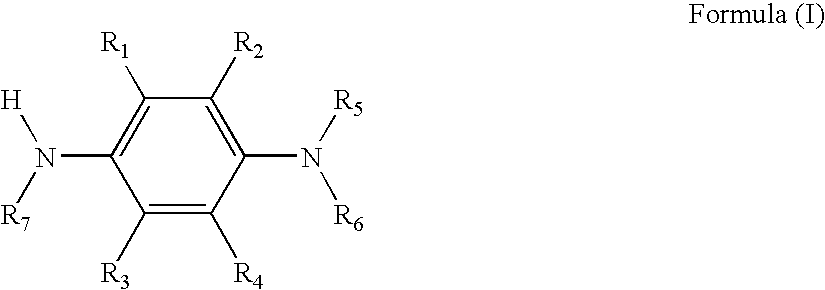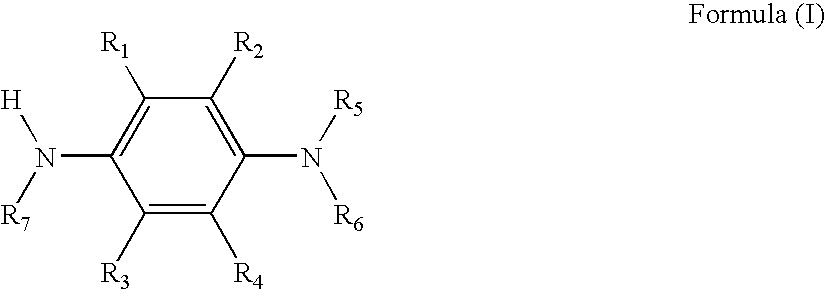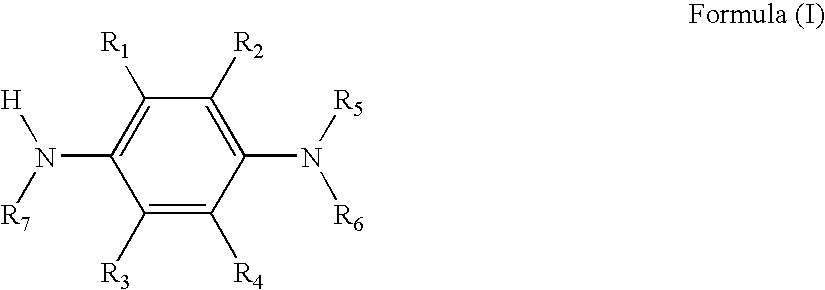Image forming method using photothermographic material
- Summary
- Abstract
- Description
- Claims
- Application Information
AI Technical Summary
Benefits of technology
Problems solved by technology
Method used
Image
Examples
example 1
1. Preparation of PET Support and Undercoating
1-1. Film Manufacturing
[0645] PET having IV (intrinsic viscosity) of 0.66 (measured in phenol / tetrachloroethane=6 / 4 (mass ratio) at 25° C.) was obtained according to a conventional manner using terephthalic acid and ethylene glycol. The product was pelletized, dried at 130° C. for 4 hours, and colored blue with the blue dye (1,4-bis(2,6-diethylanilinoanthraquinone). Thereafter, the mixture was extruded from a T-die and rapidly cooled to form a non-tentered film.
[0646] The film was stretched along the longitudinal direction by 3.3 times using rollers of different peripheral speeds, and then stretched along the transverse direction by 4.5 times using a tenter machine. The temperatures used for these operations were 110° C. and 130° C., respectively. Then, the film was subjected to thermal fixation at 240° C. for 20 seconds, and relaxed by 4% along the transverse direction at the same temperature. Thereafter, the chucking part was slit...
example 2
1. Preparation of Fluorescent Intensifying Screen A
[0763] 1) Preparation of Undercoat Layer
[0764] A light reflecting layer comprising alumina powder was coated on a polyethylene terephthalate film (support) having a thickness of 250 μm in a similar manner to Example 4 in JP-A. No. 2001-124898. The light reflecting layer, which had a film thickness of 50 μm after drying, was prepared.
[0765] 2) Preparation of Fluorescent Substance Sheet
[0766] 250 g of BaFBr:Eu fluorescent substance (mean particle size of 3.5 μm), 8 g of polyurethane type binder resin (manufactured by Dai Nippon Ink & Chemicals, Inc., trade name: PANDEX T5265M), 2 g of epoxy type binder resin (manufactured by Yuka Shell Epoxy Co., Ltd., trade name: EPIKOTE 1001) and 0.5 g of isocyanate compounds (manufactured by Nippon Polyurethane Industry Co., Ltd., trade name: CORONATE HX) were added into methylethylketone, and the mixture was then dispersed by a propeller mixer to prepare the coating solution for the fluoresce...
example 3
[0775] A silver halide emulsion prepared similar to the silver halide emulsion B of Example 1 was kept at 38° C. with stirring, and thereto was added 5 mL of a 0.34% by weight methanol solution of 1,2-benzisothiazoline-3-one, and after 20 minutes the temperature was elevated to 45° C. At 20 minutes after elevating the temperature, sodium benzene thiosulfonate in a methanol solution was added at 7.6×10−5 mol per 1 mol of silver. At additional 5 minutes later, sulfur sensitizer 4-oxo-3-benzyl-oxazolidine-2-thione in a methanol solution was added at 4.5×10−5 mol per 1 mol of silver and further, after 10 minutes, chloroauric acid in an aqueous solution at 8×10−6 mol per 1 mol of silver and potassium thiocyanate in an aqueous solution at 8×10−3 mol per 1 mol of silver were added, and subjected to ripening for 60 minutes.
[0776] And then, 1.3 mL of a 0.8% by weight N,N′-dihydroxy-N″,N″-diethylmelamine in methanol solution was added thereto, and at additional 4 minutes thereafter, 5-methyl...
PUM
 Login to View More
Login to View More Abstract
Description
Claims
Application Information
 Login to View More
Login to View More - R&D
- Intellectual Property
- Life Sciences
- Materials
- Tech Scout
- Unparalleled Data Quality
- Higher Quality Content
- 60% Fewer Hallucinations
Browse by: Latest US Patents, China's latest patents, Technical Efficacy Thesaurus, Application Domain, Technology Topic, Popular Technical Reports.
© 2025 PatSnap. All rights reserved.Legal|Privacy policy|Modern Slavery Act Transparency Statement|Sitemap|About US| Contact US: help@patsnap.com



